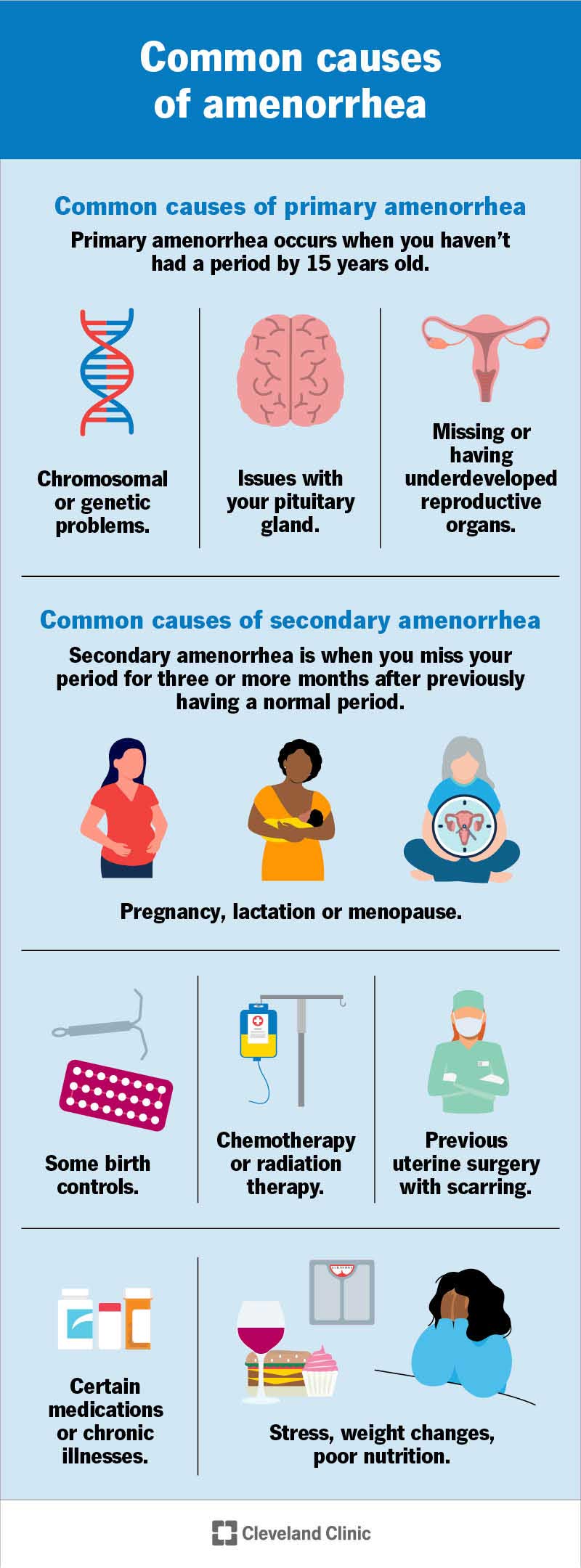Amenorrhea is missing one or more periods. Talk to your healthcare provider if you’re older than 15 and haven’t gotten your first period (primary amenorrhea) or you’ve missed a period for three or more months (secondary amenorrhea). Amenorrhea is often a sign of a treatable condition. With treatment, your regular menstrual cycle will usually resume.

Amenorrhea is when you don’t get your menstrual period. There are two kinds of amenorrhea: primary and secondary. Primary amenorrhea is when a person older than 15 has never gotten their first period. Secondary amenorrhea happens when a person doesn’t get a period for more than three months.
A complex system of hormones controls your menstrual cycle. Every cycle, these hormones prepare your uterus for a possible pregnancy. If there’s no pregnancy that cycle, you shed your uterine lining. That shedding is your period. There are many factors that can affect your period including issues with the following organs and structures:
Advertisement
Cleveland Clinic is a non-profit academic medical center. Advertising on our site helps support our mission. We do not endorse non-Cleveland Clinic products or services. Policy
Primary amenorrhea is when you haven’t gotten your first period by age 15 or within five years of the first signs of puberty (such as developing breasts). It’s usually due to genetic conditions (conditions you’re born with) or acquired abnormalities (conditions that develop after birth).
Secondary amenorrhea is when you’ve been getting regular periods, but you stop getting your period for at least three months, or your period stops for six months when they were previously irregular. Common reasons for this type of amenorrhea include:
About 1 in 4 women and people assigned female at birth who aren’t pregnant, breastfeeding or going through menopause experience amenorrhea at some point in their lives.
The main symptom is the lack of periods. Other symptoms depend on the cause. You may experience:
Advertisement
The different types of amenorrhea have different causes. Some causes happen naturally on their own, while others may be a sign of a medical condition or problem.
Natural (or normal) reasons to miss your period include:
Primary amenorrhea occurs when you haven’t had a period by 15 years old. Common causes include:
Secondary amenorrhea is when you miss your period for three or more months after previously having a normal period. Common causes include:
The following medical conditions may also cause secondary amenorrhea:
Risk factors for amenorrhea include:
Amenorrhea isn’t life-threatening. However, some causes can lead to long-term complications, so amenorrhea should always be evaluated by a healthcare provider. Having amenorrhea may make you more likely to develop:
Advertisement
Contact a healthcare provider if you miss a period. They’ll ask you about your symptoms and medical history, including your menstrual history. Your provider will perform a physical exam and a pelvic exam.
Your healthcare provider may want to do some tests, including:
Diagnosing amenorrhea can be challenging. If the cause of amenorrhea isn’t obvious, such as pregnancy or menopause, your provider may ask you to keep a record of changes in your menstrual cycle. This history of your periods can help your provider figure out a diagnosis.
Using an app or a journal, note:
If your period stopped because of menopause, lactation or pregnancy, your provider won’t need to treat it.
In other cases, your treatment will depend on the cause and may include:
In addition, your healthcare provider may recommend some treatments to help with the side effects of amenorrhea:
Surgery for amenorrhea is rare. Your healthcare provider may recommend it if you have:
Most cases of amenorrhea are treatable. With treatment, your periods should start to happen regularly. It can take a few months for your periods to come back, but in most cases, they will. Talk to your healthcare provider about what you can expect with treatment.
Maintaining good overall health can help prevent some causes of secondary amenorrhea. Try to:
Typically, your period will return once you treat the underlying cause. However, it may take time to become regular again.
In some cases, you may have a health problem that means you’ll never have a period. If that’s the case, your provider can talk to you about fertility options if you wish to become pregnant.
You should call your healthcare provider if you miss three months of periods. Visit your provider if you miss a period and:
When you talk to your healthcare provider, ask:
Yes, some people notice they don’t get their period after stopping birth control pills (post-pill amenorrhea). This is because your body is trying to remember how to produce the hormones necessary for ovulation and menstruation. It can take up to three months for your body to resume menstruation. Talk to your healthcare provider if you go longer than four to six months without a period after stopping the pill.
No, amenorrhea isn’t a form of infertility. However, not getting a menstrual period can lead to not being able to get pregnant. If having a child is your goal and your menstrual cycle is irregular or absent, contact your healthcare provider for an appointment.
A note from Cleveland Clinic
Talk to your healthcare provider if you’re older than 15 and haven’t gotten your period or you’ve had a normal menstrual cycle but now you’re missing periods. Amenorrhea is usually the sign of a treatable condition. Once your provider figures out what’s causing missed periods, you can get care to regulate your cycle. You may need lifestyle changes or hormonal treatment to help resume normal menstrual cycles.
Last reviewed on 03/23/2023.
Learn more about the Health Library and our editorial process.
Advertisement
Cleveland Clinic is a non-profit academic medical center. Advertising on our site helps support our mission. We do not endorse non-Cleveland Clinic products or services. Policy